| Pages:
1
2
3 |
David K
Honored Nomad
        
Posts: 65407
Registered: 8-30-2002
Location: San Diego County
Member Is Offline
Mood: Have Baja Fever
|
|
The missions and their ruins are an excellent draw for visitors to Baja California. Nearly all can be reached by 2WD vehicle.
Those of us who went to school in California are awakened to the fack that San Diego was not California's first mission, but actually the 19th
California mission (founded after San Fernando Velicata). It is simply the first mission located inside the part of California the United States kept
after the Mexican War.
The peninsula was called California first, and the water off the east coast is the Gulf of California.
The great area north of the peninsula became known as 'Alta California' as explorers ventured that direction. Eventually, 'Baja' was added to
'California' to clarify the peninsular part of California. After the Mexican War, the Americans dropped the 'Alta' from California. So, a complete
reversal of names: The original California is Baja California and the original Alta California is California.
|
|
|
David K
Honored Nomad
        
Posts: 65407
Registered: 8-30-2002
Location: San Diego County
Member Is Offline
Mood: Have Baja Fever
|
|
North to South, Baja Norte Missions:
Missions you can drive to, north to south...
Descanso (exit Hwy. 1 near Cantamar):

2nd site, built in 1830. Floor recently uneartherd and covered, next to newer church.
Guadalupe (exit Hwy. 3 in Guadalupe/ Fro. Zarco):

1834, the last mission founded in all the Californias
San Miguel:
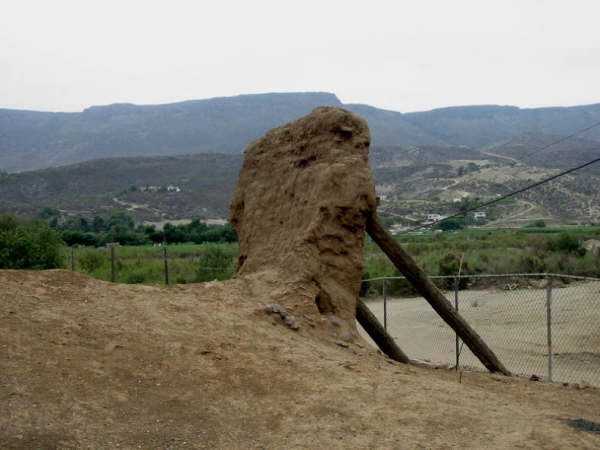
On Hwy. 1 in La Mision, 2nd site founded in 1788.
Santa Catalina (5 mi. from Hwy. 3 at Independencia, by Santa Catarina village:
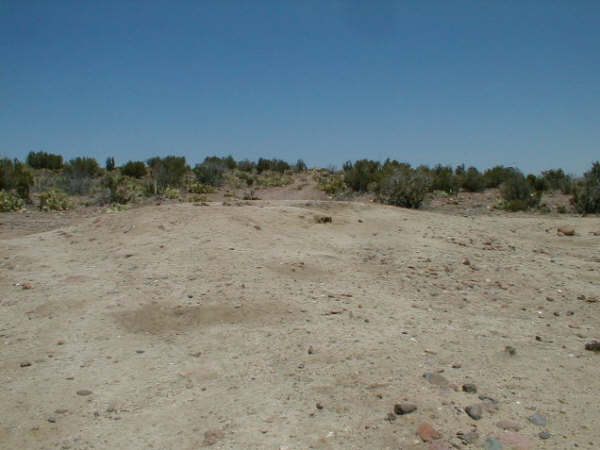
1797, the last Spanish-era mission founded.
Santo Tomas (Hwy. 1 in Santo Tomas, next to El Palomar park):
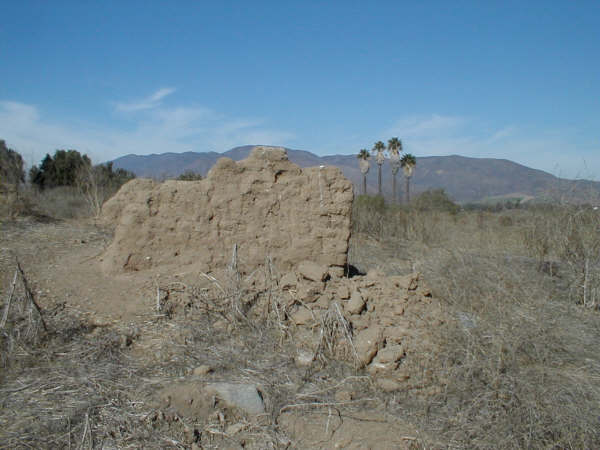
3rd site (1799). The previous 2 sites are along the road to La Bocana/ Pto. Sto. Tomas, approx. 3 miles west.
San Vicente:

1780. A mile west off Hwy. 1, in San Vicente.
*Not included: Mision San Pedro Martir (requires a 2 day hike one way to reach)*
Santo Domingo:

2nd site, 1793. 5 miles east of Hwy. 1 near Colonia V. Guerrero, north side of bridge.
El Rosario (Arriba):

1774, 1st site. Just off Hwy. 1 in El Rosario
El Rosario (Abajo):
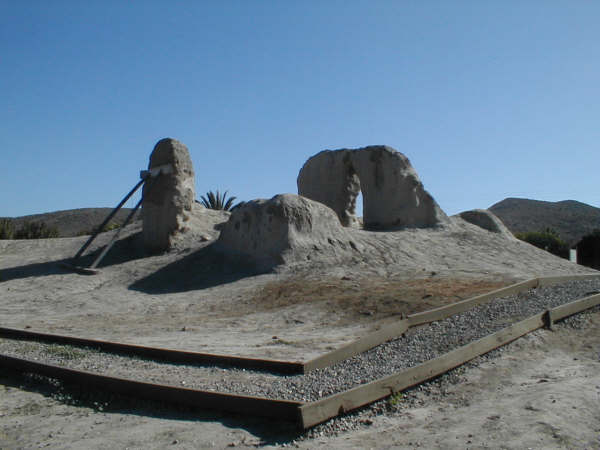
1802, 2nd site. 2 miles from Hwy. 1, south side of river valley.
San Fernando Velicata:

1769, first California mission founded by Franciscan Junipero Serra. 3 miles off Hwy. 1 at El Progreso
The remaining missions in Baja Norte are several dirt miles from Hwy. 1...
Santa Maria de los Angeles:

1767, 2nd location for the final Jesuit founded mission. Extreme difficult 4WD road, 15 miles from Santa Ynez off Hwy. 1.
Calamajue:
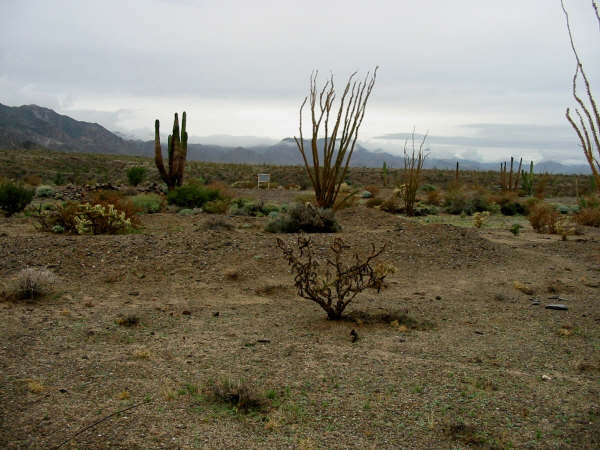
1766, 1st location for final Jesuit mission. 14 dirt miles from Coco's Corner (Coco's is 13 miles from Hwy. 1 at Laguna Chapala)
San Borja:

1762-1773 adobe ruins behind stone church built up to 1801. 22 miles off Hwy. 1 at Rosarito or same from L.A. Bay highway.
Santa Gertrudis:


Founded in 1752, the original name planned for this mission was Dolores del Norte. The benefactor requested Santa Gertrudis. 37 miles from Hwy. 1 via
Guillermo Prieto or 48 miles via El Arco.
For satellite views of all mission sites and GPS waypoints, go to http://vivabaja.com/missions4
For more details, historic photos, etc. go to http://vivabaja.com/bajamissions
Get the book with all the missions: http://oldmissions.com
[Edited on 9-21-2013 by David K]
|
|
|
David K
Honored Nomad
        
Posts: 65407
Registered: 8-30-2002
Location: San Diego County
Member Is Offline
Mood: Have Baja Fever
|
|
Missions along Hwy. 1 in Baja Sur
Heading south into Baja California Sur, take the paved side road a mile+ into San Ignacio:

Founded in 1728, stone church completed in 1786.
Mulege (Mision Santa Rosalia de Mulege):

Founded in 1705, stone church completed in 1766. Located to the right of Highway 1 where it crosses the river.
Loreto:

California's FIRST mission, founded in 1697 stone church completed in 1752. Earthquake destroyed much in 1877 and bell tower replaced in 1950's.
Located in the center of town.
Ligui (San Juan Bautista de Ligui/ Malibat):

East of Hwy. 1 along the road to Playa Ligui at the Ensenada Blanca road jcn., nothing remains after flash floods destroyed the site in 2001. A cross
was placed nearby to mark the area by the mission site.
Just over 20 miles west from Loreto via a paved road (not completed) is the magnificent original stone mission of San Javier:
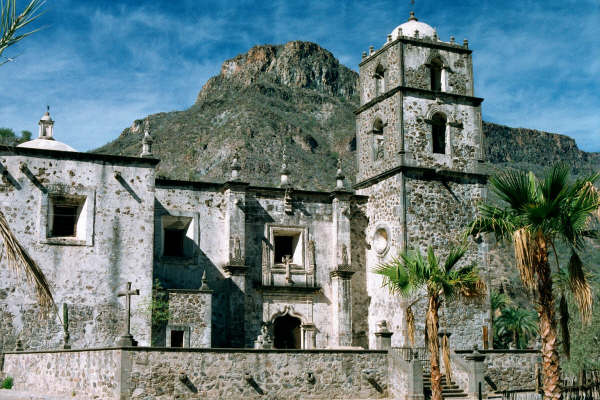
California's second mission founded in 1699, this stone church was built from 1744 to 1758.
San Luis Gonzaga:

Founded in 1737, the stone church was built in the 1750's. Located 23 dirt miles east from Hwy. 1, south of Ciudad Constitucion.
Sadly, none of the remaining missions to the south can be seen in their original construction. Their sites have been either lost or built over by
modern buildings or churches.
They are the missions of La Paz, Santiago, San Jose del Cabo and Todos Santos (where 2 missions were established: Santa Rosa and the 2nd location for
the La Paz mission). See http://vivabaja.com/bajamission for more details and photos.
Other missions along different roads in Baja Sur include Guadalupe de Huasinapi, La Purisima (2 sites), San Jose de Comondu (2 sites), and Los Dolores
(2 sites)!
[Edited on 6-16-2011 by David K]
|
|
|
David K
Honored Nomad
        
Posts: 65407
Registered: 8-30-2002
Location: San Diego County
Member Is Offline
Mood: Have Baja Fever
|
|
The Other Baja California Sur Missions
Guadalupe de Huasinapi:

La Purisima:
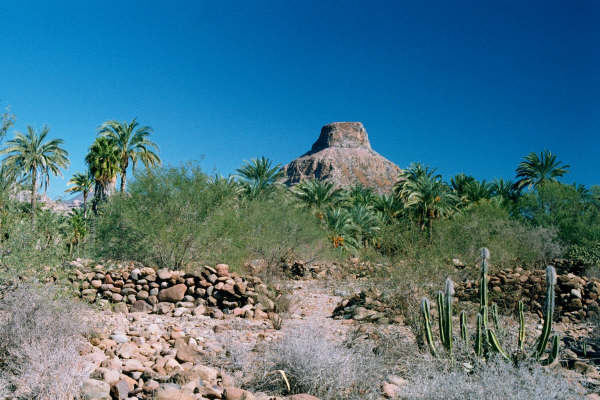
San Jose de Comondu:

Los Dolores (Apate):
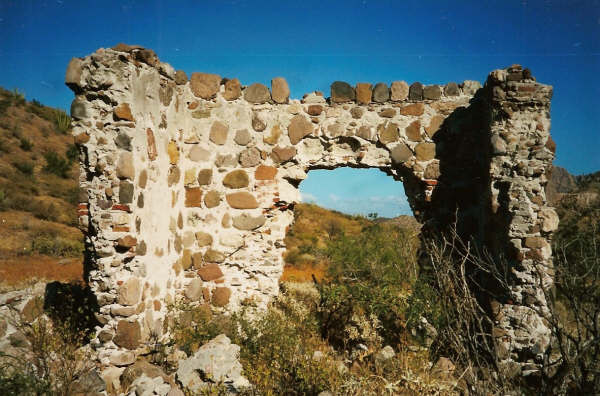
Los Dolores (Chilla/ La Pasion):

Little or nothing remains from the original mission church buildings at La Paz, Todos Santos, Santiago or San Jose del Cabo. In La Paz, a plaque marks
the possible site and modern churches cover other sites.
[Edited on 7-21-2011 by David K]
|
|
|
gnukid
Ultra Nomad
    
Posts: 4411
Registered: 7-2-2006
Member Is Offline
|
|
To add cultural significance, what led to the worldwide reformation movement?
How did people worldwide, without modern telecommunications join together in thought and mindset against the actions and elements of the jesuits
missions movement and create a movement to ban the jesuits and why?
Why did missionaries want the missions?
What decisions led to the choice of locations?
What role did indians play in bringing about the missions?
|
|
|
David K
Honored Nomad
        
Posts: 65407
Registered: 8-30-2002
Location: San Diego County
Member Is Offline
Mood: Have Baja Fever
|
|
| Quote: | Originally posted by gnukid
To add cultural significance, what led to the worldwide reformation movement?
How did people worldwide, without modern telecommunications join together in thought and mindset against the actions and elements of the jesuits
missions movement and create a movement to ban the jesuits and why?
Why did missionaries want the missions?
What decisions led to the choice of locations?
What role did indians play in bringing about the missions? |
The Jesuits were expelled from the New World by order of King Carlos of Spain following rumors that the padres were not sharing accumilated wealth
with the king. Rumors were spread by the enemies of the Jesuits, naturally... and were not true. The padres could barely feed themslves and had no
opportunity to mine gold, silver, or collect pearls (other than any found while eating oysters)!
The Jesuits saw the New World as a land full of souls to save... to do "God's work".
Location was where the natives were... where there was water and an ability to farm the land. Often the first location of a mission was changed
because there wasn't enough land or water to have agriculture... The natives were hunter/ gatherers and never cultivated any crops.
The natives were given food (often 'pozole') in order to intice them to work and remain with the mission. They must have enjoyed that over eating
lizards and mice?
Maybe the best source of history of the Jesuit period in Baja California is Harry Crosby's 'Antigua California' c1994
The Jesuits were replaced by the Franciscan Order, who soon wanted to head into Alta California where the native population had not yet been seriously
reduced by introduced epidemics and disease. The Franciscans founded just one mission in Baja, then handed over the peninsula to the Dominicans who
established 9 more missions in the northern 1/3 of Baja.
The Dominicans also completed the stone mission at San Ignacio and built the stone missions at Santa Gertrudis and San Borja, replacing the adobe
churches built by the Jesuits and Franciscans before them.
The mission system was the tool used by Spain to occupy the New World in advance of European settlers who would replace or 'join' with the native
population.
|
|
|
David K
Honored Nomad
        
Posts: 65407
Registered: 8-30-2002
Location: San Diego County
Member Is Offline
Mood: Have Baja Fever
|
|
Mission Location Maps
The Jesuit Missions (1697-1767):
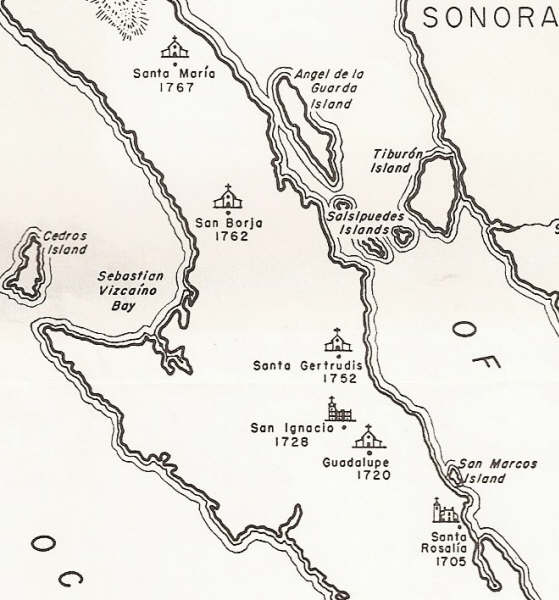
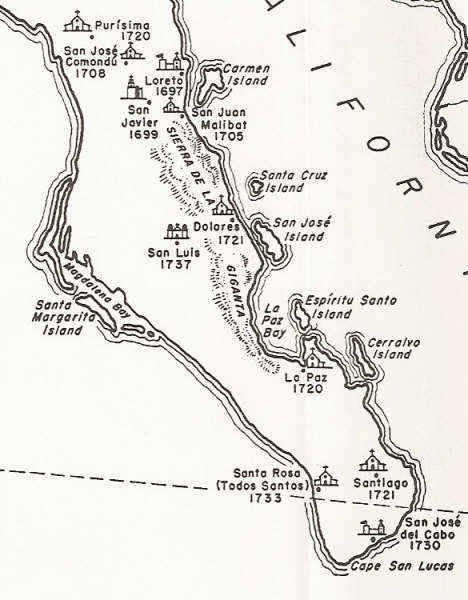
The Franciscan and Dominican Missions (1769-1849):

|
|
|
David K
Honored Nomad
        
Posts: 65407
Registered: 8-30-2002
Location: San Diego County
Member Is Offline
Mood: Have Baja Fever
|
|
VISITAS... 4 examples
The missions had 'vistas' or visiting stations in their territory to serve the native population who all could not live at the head mission.
A visita was often very much like a mission except it did not have a preist full time. The mission's priest would travel to the visitas in his
territory to perform services. Many visitas were extensive enough to appear like missions to modern travelers, and often they were incorrectly called
missions on maps and in books. In fact, they belonged to a mission until the time came when they themselves became a seperate mission and had a priest
of their own.
The Pilar de la Paz mission visita of 'Todos Santos' became a seperate mission of 'Santa Rosa de las Palmas' and after many years, the La Paz mission
closed at La Paz and moved to Santa Rosa, replacing that mission. The mission was usually always called Todos Santos, as it was the original location
name.
The Los Dolores Apate mission visita of La Pasion (at the place the Indians called Chilla) became the Los Dolores mission when that mission moved out
of the canyon near the gulf. The mission was usually called La Pasion after the move, but officially it was Los Dolores Chilla.
The next mission to be founded north of San Ignacio was proposed to be called Dolores del Norte, and the Jesuits documents and a map published in 1757
(from ~1747 data) lists it... When the Jesuits obtained funds of that mission, its benefactor requested it to be called Santa Gertrudis. The idea of a
lost mission of Dolores del Norte persisted. The adobe visita of Santa Gertrudis in San Pablo Canyon has been called Dolores del Norte in some books
and even by INAH (Mexico's Dept. of Archeology). The people of San Francisco de la Sierra believed the old mission period walls in their village were
the remains of Dolores del Norte when visited by Choral Pepper with the Erle Stanley Gardner expedition, in the early 1960's.

Visita San Pablo, Marquis McDonald photo in 1949

Phillip Lang photo in 2010
The last Jesuit mission (1766) was founded at the San Borja visita of Calamajue, but in a few months moved north because the water became unfit to
grow crops. When re-established at the new site in 1767 the name chosen was Santa Maria de los Angeles. The Jesuits built palm huts at the new site.
Only a few months passed before the Jesuits were expelled from the New World. The Franciscans in 1768 built the adobe church and side building we see
ruins of today. Following the Franciscan founding of Mision San Fernando Velicata in 1769, Santa Maria was reduced in status to a visita the same
year.
See more on visitas here: http://vivabaja.com/missions3/
|
|
|
Baja Bucko
Nomad
 
Posts: 288
Registered: 9-23-2003
Member Is Offline
|
|
David-San Pablo looks the same today but is now heavily overgrown w cholla and other nasty sticky things....I was there last year by mule from SF. If
I can locate the pics I will send you a more recent one.
Teddi
My other 4WD is a Baja Mule!
La Mula Mil Survivor 2013-2014!
1000 miles by mule from the tip to Tecate!
|
|
|
David K
Honored Nomad
        
Posts: 65407
Registered: 8-30-2002
Location: San Diego County
Member Is Offline
Mood: Have Baja Fever
|
|
| Quote: | Originally posted by Baja Bucko
David-San Pablo looks the same today but is now heavily overgrown w cholla and other nasty sticky things....I was there last year by mule from SF. If
I can locate the pics I will send you a more recent one.
Teddi |
Thanks Teddi... any visita photo I would enjoy having, as I am sure you have seen many more as you rode along El Camino Real!
In the photos above taken 61 years apart, the isolation and dry climate has preserved San Pablo very well... It also resembles Santa Maria and that is
perhaps why travelers in the 1900's thought that was the lost mission of Dolores del Norte?
|
|
|
David K
Honored Nomad
        
Posts: 65407
Registered: 8-30-2002
Location: San Diego County
Member Is Offline
Mood: Have Baja Fever
|
|
There are many mission visitas and ruins from the mission period all over Baja. Sadly, finding photos of them all is not easy... Photographs are the
only true way of preserving mission sites, as nature and man erase the construction made hundreds of years ago. The same is true of the cliff and cave
paintings and petroglyphs. Take photos and share them so we all can have a look at the past... our Baja time machine!
|
|
|
David K
Honored Nomad
        
Posts: 65407
Registered: 8-30-2002
Location: San Diego County
Member Is Offline
Mood: Have Baja Fever
|
|
Missions on the peninsula at various points in time
In 1697, Loreto was the only mission in operation on the peninsula.
30 years later (1727):
1) Nuestra Seņora de Loreto Concho 1697-1829
2) San Francisco Javier de Biaundo 1699-1817 (moved 5 miles south in 1710)
4) Santa Rosalia de Mulege 1705-1828
5) San Jose de Comondu 1708-1827 (moved 22 miles south in 1736)
6) La Purisima Concepcion de Cadegomo 1720-1822 (moved 10 miles south in 1735)
7a) Nuestra Seņora del Pilar de la Paz Airapi 1720-1748 (moved to Todos Santos in 1748)
8) Nuestra Seņora de Guadalupe de Huasinapi 1720-1795
9a) Nuestra Seņora de los Dolores Apate 1721-1741 (moved to La Pasion in 1741)
10) Santiago el Apostal Aiņini 1724-1795 (moved 2 miles south in 1734)
Nine missions were active and only one (#3, Ligui) was closed, in 1721.
==============================================
Jump ahead 30 more years to 1757:
1) Nuestra Seņora de Loreto Concho 1697-1829
2) San Francisco Javier de Biaundo 1699-1817 (moved 5 miles south in 1710)
4) Santa Rosalia de Mulege 1705-1828
5) San Jose de Comondu 1708-1827 (moved 22 miles south in 1736)
6) La Purisima Concepcion de Cadegomo 1720-1822 (moved 10 miles south in 1735)
7b) Nuestra Seņora del Pilar de la Paz (Todos Santos) 1748-1840
8) Nuestra Seņora de Guadalupe de Huasinapi 1720-1795
9b) Nuestra Seņora de los Dolores Chilla (La Pasion) 1741-1768
10) Santiago el Apostal Aiņini 1724-1795 (moved 2 miles south in 1734)
11) Nuestro Seņor San Ignacio Kadakaaman 1728-1840
12) San Jose del Cabo Aņuiti 1730-1840 (moved 5 miles north, then back, then 1 mile north), (from 1748-1768 it was reduced in staus to a visita of
Santiago).
14) San Luis Gonzaga Chiriyaqui 1737-1768
15) Santa Gertrudis de Cadacaman 1751-1822
Thirteen missions were active and between the years 1727 and 1757 and during that period one mission operated for 15 years:
#13) Santa Rosa de las Palmas (Todos Santos) 1733-1748 (absorbed by moved La Paz mission in 1748)
====================================================
Jump ahead 30 more years to 1787... The Jesuits were replaced by the Franciscans in 1768, and the Dominicans replaced the Franciscans in Baja, in
1773.
1) Nuestra Seņora de Loreto Concho 1697-1829
2) San Francisco Javier de Biaundo 1699-1817 (moved 5 miles south in 1710)
4) Santa Rosalia de Mulege 1705-1828
5) San Jose de Comondu 1708-1827 (moved 22 miles south in 1736)
6) La Purisima Concepcion de Cadegomo 1720-1822 (moved 10 miles south in 1735)
7b) Nuestra Seņora del Pilar de la Paz (Todos Santos) 1748-1840
8) Nuestra Seņora de Guadalupe de Huasinapi 1720-1795
10) Santiago el Apostal Aiņini 1724-1795 (moved 2 miles south in 1734)
11) Nuestro Seņor San Ignacio Kadakaaman 1728-1840
12) San Jose del Cabo Aņuiti 1730-1840 (moved 5 miles north, then back, then 1 mile north)
15) Santa Gertrudis de Cadacaman 1751-1822
16) San Francisco de Borja Adac 1762-1818
18) San Fernando Velicata 1769-1818
19) Nuestra Seņora del Rosario Viņaraco 1774-1832
20) Santo Domingo 1775-1839
21) San Vicente Ferrer 1780-1833
22) San Miguel Arcangel 1787-1834
Seventeen mission were active in Baja in 1787. During the period from 1757 to 1787 the missions at San Luis Gonzaga, Dolores (La Pasion), and Santa
Maria were closed. Santa Maria was active only 3 years from 1766 to 1769 at two different sites (first at Calamajue and then moved to Santa Maria).
====================================================
Jump ahead 30 more years to 1817... Mexico declaired its independence from Spain in 1810, but the mission system continued to operate in remote
California, far removed from the conflict, but also cut off from regular supplies.
1) Nuestra Seņora de Loreto Concho 1697-1829
2) San Francisco Javier de Biaundo 1699-1817 (moved 5 miles south in 1710)
4) Santa Rosalia de Mulege 1705-1828
5) San Jose de Comondu 1708-1827 (moved 22 miles south in 1736)
6) La Purisima Concepcion de Cadegomo 1720-1822 (moved 10 miles south in 1735)
7b) Nuestra Seņora del Pilar de la Paz (Todos Santos) 1748-1840
11) Nuestro Seņor San Ignacio Kadakaaman 1728-1840
12) San Jose del Cabo Aņuiti 1730-1840 (moved 5 miles north, then back, then 1 mile north)
15) Santa Gertrudis de Cadacaman 1751-1822
16) San Francisco de Borja Adac 1762-1818
18) San Fernando Velicata 1769-1818
19) Nuestra Seņora del Rosario Viņaraco 1774-1832 (Moved 2 miles west in 1802)
20) Santo Domingo 1775-1839 (Moved 2 miles east in 1793)
21) San Vicente Ferrer 1780-1833
22) San Miguel Arcangel 1787-1834 (moved 7 miles west in 1788)
23) Santo Tomas de Aquino 1791-1849 (moved 1 mile northeast in 1794, and 2 miles east in 1799)
25) Santa Catalina Virgen y Martir 1797-1840
26) El Descanso 1817-1834
Eighteen missions were in operation in 1817, but it was about the end of the system as most of the native population had died off due to disease. The
next year (1818) three more mission were closed.
=====================================================
Ten years more (1827):
1) Nuestra Seņora de Loreto Concho 1697-1829
4) Santa Rosalia de Mulege 1705-1828
5) San Jose de Comondu 1708-1827 (moved 22 miles south in 1736)
7b) Nuestra Seņora del Pilar de la Paz (Todos Santos) 1748-1840
11) Nuestro Seņor San Ignacio Kadakaaman 1728-1840
12) San Jose del Cabo Aņuiti 1730-1840 (moved 5 miles north, then back, then 1 mile north)
19) Nuestra Seņora del Rosario Viņaraco 1774-1832 (Moved 2 miles west in 1802)
20) Santo Domingo 1775-1839 (Moved 2 miles east in 1793)
21) San Vicente Ferrer 1780-1833
22) San Miguel Arcangel 1787-1834 (moved 7 miles west in 1788)
23) Santo Tomas de Aquino 1791-1849 (moved 1 mile northeast in 1794, and 2 miles east in 1799)
25) Santa Catalina Virgen y Martir 1797-1840
26) El Descanso 1817-1834 (Also called 'San Miguel Nuevo', moved 1/2 mile north in 1830)
Thirteen missions were operating in 1827.
===================================================
Jump ahead 10 years more, to 1837:
7b) Nuestra Seņora del Pilar de la Paz (Todos Santos) 1748-1840
11) Nuestro Seņor San Ignacio Kadakaaman 1728-1840
12) San Jose del Cabo Aņuiti 1730-1840 (moved 5 miles north, then back, then 1 mile north)
20) Santo Domingo 1775-1839 (Moved 2 miles east in 1793)
23) Santo Tomas de Aquino 1791-1849 (moved 1 mile northeast in 1794, and 2 miles east in 1799)
25) Santa Catalina Virgen y Martir 1797-1840
27) Nuestra Seņora de Guadalupe 1834-1840
Seven missions remained open in 1737, but in the next 3 years all of them except Santo Tomas closed. The padre at Santo Tomas kept his mission open
until 1849 at which point he gave up after one of the member Indians sold alter pieces to passing 49er's on their way to the Alta California gold
fields.
[Edited on 4-26-2012 by David K]
|
|
|
David K
Honored Nomad
        
Posts: 65407
Registered: 8-30-2002
Location: San Diego County
Member Is Offline
Mood: Have Baja Fever
|
|
On a mission...
I am going to produce some maps that show missions on the peninsula at various times in history. The idea is to visualize easily where 'civilization'
was established in a rugged land.
|
|
|
David K
Honored Nomad
        
Posts: 65407
Registered: 8-30-2002
Location: San Diego County
Member Is Offline
Mood: Have Baja Fever
|
|
| Quote: | Originally posted by David K
On a mission...
I am going to produce some maps that show missions on the peninsula at various times in history. The idea is to visualize easily where 'civilization'
was established in a rugged land. |
Those maps are in this post: http://forums.bajanomad.com/viewthread.php?tid=56870
|
|
|
David K
Honored Nomad
        
Posts: 65407
Registered: 8-30-2002
Location: San Diego County
Member Is Offline
Mood: Have Baja Fever
|
|
So, some basic facts... that may upset some California public school book authors.
The peninsula that we today call Baja California was California first... and the new land north of the peninsula would become known as Alta
California... the land 'up' from the peninsula. Originally it was all California when it was believed to be an island.
LORETO (not San Diego) was the first California mission... and it was in operation for the longest (132 years).
18 missions were established on the California peninsula before San Diego's mission was founded in 1769.... as the 19th California mission.
Junipero Serra founded one mission in 'California' before San Diego... it was San Fernando Velicata (between Santa Maria and El Rosario).
Once the Franciscan Order was established in 'Alta California', they no longer wanted to operate the peninsula missions (some of which they looted to
decorate the new Alta California missions) with its falling native population. They handed over the peninsula to the Dominican Order which continued
to operate the original Jesuit missions that had not closed by 1773.
The Dominicans finished the construction of the San Ignacio stone mission church, then built the stone mission churches at Santa Gertrudis and San
Borja, and established 9 more missions (all made of adobe) from El Rosario to Descanso and Guadalupe.
California was divided between Baja and Alta just north of Descanso.
When the United States took control of Alta California, the border line was adjusted north, and the 'Alta' was dropped from the official name. What
was originally California and Alta California was reversed to Baja California and California. The body of water between the peninsula and mainland
Mexico did not change names and still is the Gulf of California... with a popular romantic nickname 'Sea of Cortez'.
[Edited on 4-26-2012 by David K]
|
|
|
DianaT
Select Nomad
      
Posts: 10020
Registered: 12-17-2004
Member Is Offline
|
|
| Quote: | Originally posted by David K
The natives were given food (often 'pozole') in order to intice them to work and remain with the mission. They must have enjoyed that over eating
lizards and mice?
|
Your list, maps, directions, etc. are very good for anyone who wants to explore the working missions and the ruins of others. 
But, I can't believe you said that! For the Native Americans, the Mission system was hardly a picnic. The romanticized so called history of this
system usually ignores the reality.  
|
|
|
David K
Honored Nomad
        
Posts: 65407
Registered: 8-30-2002
Location: San Diego County
Member Is Offline
Mood: Have Baja Fever
|
|
If you think the Cochimi did not eat mice and lizards, then it is YOU who need to read more if you refuse to believe my words here.
The mission system was Spain's method to occupy the territory ahead of the Russians or British, and convert the native population into good Spanish
citizens. The diseases the natives couldn't resist were introduced by the Europeans and killed them. It was not the intention of the padres and it led
to the systems failure in most of Lower California.
[Edited on 2-27-2012 by David K]
|
|
|
DianaT
Select Nomad
      
Posts: 10020
Registered: 12-17-2004
Member Is Offline
|
|
| Quote: | Originally posted by David K
If you think the Cochimi did not eat mice and lizards, then it is YOU who need to read more if you refuse to believe my words here.
The mission system was Spain's method to occupy the territory ahead of the Russians or British, and convert the native population into good Spanish
citizens. The diseases the natives couldn't resist were introduced by the Europeans and killed them. It was not the intention of the padres and it led
to the systems failure in most of Lower California.
[Edited on 2-27-2012 by David K] |
I was not questioning what anyone ate----it is the overall romanticized history you want to believe about the mission system. But never mind----if
that is what you choose to believe, so be it. 
[Edited on 2-28-2012 by DianaT]
|
|
|
David K
Honored Nomad
        
Posts: 65407
Registered: 8-30-2002
Location: San Diego County
Member Is Offline
Mood: Have Baja Fever
|
|
| Quote: | Originally posted by DianaT
| Quote: | Originally posted by David K
If you think the Cochimi did not eat mice and lizards, then it is YOU who need to read more if you refuse to believe my words here.
The mission system was Spain's method to occupy the territory ahead of the Russians or British, and convert the native population into good Spanish
citizens. The diseases the natives couldn't resist were introduced by the Europeans and killed them. It was not the intention of the padres and it led
to the systems failure in most of Lower California.
[Edited on 2-27-2012 by David K] |
I was not questioning what anyone ate----it is the overall romanticized history you want to believe about the mission system. But never mind----if
that is what you choose to believe, so be it. 
[Edited on 2-28-2012 by DianaT] |
Not MY beliefs, what has been documented in historical records, ie. BOOKS.
|
|
|
David K
Honored Nomad
        
Posts: 65407
Registered: 8-30-2002
Location: San Diego County
Member Is Offline
Mood: Have Baja Fever
|
|
Speaking of books... very soon, a NEW book on ALL the California missions (Baja & Alta)... 48 missions will be published! The missions will be
listed in the order they were founded from 1697 to 1834. 
|
|
|
| Pages:
1
2
3 |
|

